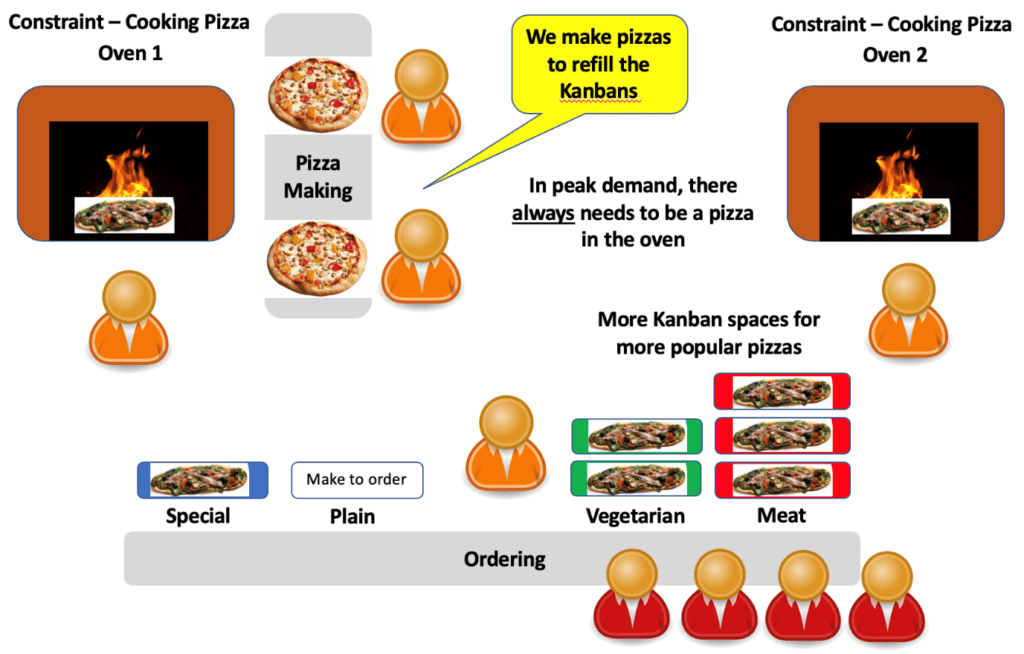
Sarah Lethbridge’s pizza productivity
Sarah Lethbridge explains how a pizza-related experience at a music festival proved to be the perfect example of how and where bottlenecks exist within the production line.
Reading Time 5 minutes
In my lectures, I often joke that once you start seeing the world from a lean perspective, things that you used to enjoy can start to become quite frustrating because you can see room for improvement everywhere. I recently had a brilliant day at a mini festival in Cardiff with my friends but the queue for a pizza nearly had me jumping over the counter and making the staff participate in one of my workshops. The queue was actually quite fun because me and my friends were catching up, but when I got to the front, I could clearly see that there were major problems in their pizza production line.
The pizza company did well in increasing productivity and minimising the amount of ingredients needed – and therefore reduced waste – as they only had three options to choose from. But I posit that they didn’t maximise the benefits that come from the simplicity of their ingredients and menu.
I only witnessed what was going on behind the counter for the few minutes I was at the front of the queue. I am not an expert in cooking pizza, but in that moment, after one hour of waiting and missing the start of the headline act, I really felt that changes could be made to get people their pizza quicker, and yes, to make that company more money.
A chain is only as strong as its weakest link
The first thing I noticed was that they had two pizza ovens but often only one in use at a time. Maybe this is how pizza ovens are meant to work, but given the queue, I would have attempted to shove a few in and hope for the best! Eli Goldratt in his book The Goal outlined his ‘Theory of Constraints’ and really elevated the importance of understanding where bottlenecks exist within your processes as they dictate your whole pace of production. In simple terms, a chain is only as strong as its weakest link. To maximise the throughput of any process, you must maximise the ability of the constraint to do its job. Cooking the pizza, whilst relatively quick because of the ovens, takes the most time in the process. Applying this concept to my pizza purchasing experience, the pizza ovens should never have been empty.
Kanban Square system
The second thing was that they were making-to-order with what appeared to be a push manufacturing process, i.e. ‘I want a vegetarian pizza’, ‘ok, we will make you one’; *roll out dough, add tomato sauce, toppings and cook* – and voila! I have tried to describe this in the diagram below.

In times of peak demand, they needed to move to more of a pull process to get people their food. I desperately (and tragically) wanted to set up just a simple Kanban square system, to encourage them to move to a replenishment pull system. Something like the below.

A Kanban is just a signal within a process to say, ‘I need one’. If the customer buys a vegetarian pizza, the vegetarian pizza Kanban space is now empty. This is a visual signal to tell the cooks that they need to make a vegetarian pizza to replace the one that has just been bought. It’s as simple as that. The downside of a Kanban food system is that if someone hasn’t bought one type of pizza in a while, it will just sit there going cold, that’s why I’d suggest that the Kanban spaces were warming plates. There is also the potential that you’ll have to throw out pizzas that haven’t been bought after a short while, which is a waste. But I think that you could probably shift these cold pizzas cheaply – or offer as samples to customers waiting in the queue, or in vicinity of the pizza van, – and are a small price to pay for a much greater throughflow of custom.
You’d need to load up the system with pizza, confident that the demand was such that you’d be able to sell many pizzas a minute. But once the system had been embedded, you could better tweak the Kanban to reflect demand, having more of the most popular pizzas ready to purchase and maybe keeping the least popular pizza to a make-to-order process to minimise waste.

The pizza company needed to decouple customer demand and production supply to maximise the human resource they had available to make and cook pizzas and the physical resource that they had to cook the pizzas – the two pizza ovens.
Lean thinking
As we waited in the queue, one of the members of the team came along in the queue and asked us how many pizzas we were going to order because they wanted to know if they had enough ingredients left to service the queue. Again, this feels like a common ‘posh food truck’ experience at festivals, they nearly always run out, and to a lean thinker this makes no sense. Indeed, most of the other food trucks on site had run out of food already and this truck was the last one that was operational, so you could say that they had best bet on the amount of ingredients they’d need.
I wonder though how many people couldn’t face that queue, and how much they could have sold if they had been more efficient? Could they have sold double what they had brought with them if they were quicker in making them? I’d suggest that the answer is, probably.
About The Author
Latest articles
Find Out More


Don’t forget, multiple participants can now join the course
Two leaders or senior managers from a business with 10 to 249 employees can now attend the 12 modules of learning and get the benefits of one-to-one mentorship.








